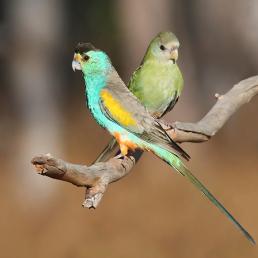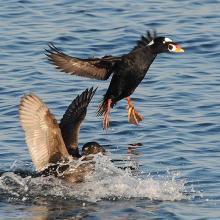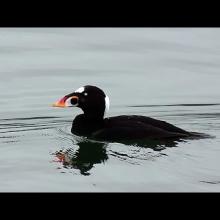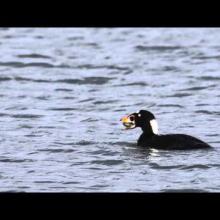

Join BirdNote tomorrow, November 30th!
Illustrator David Sibley and actor H. Jon Benjamin will face off in the bird illustration battle of the century during BirdNote's Year-end Celebration and Auction!
Surf Scoters are large colorful sea ducks. The male Surf Scoter’s huge red-orange bill with its white and black spots really stands out. It is a great tool for eating hard-shelled mollusks like clams and mussels. Surf Scoters spend the winter along the coastlines of North America. Look at the winter shore and you might see hundreds of them together at one time, diving in unison.
This show made possible by Jim and Birte Falconer of Seattle, and Idie Ulsh, helping public radio tell stories about science and nature.
BirdNote®
Surf Scoters Stand Out
Written by Bob Sundstrom
This is BirdNote.
It’s hard to mistake a puffin for any other kind of bird. But there is one bird that could pass for a puffin’s stunt double — the male Surf Scoter. These large sea ducks have oversized, mostly orange bills, black bodies, and black-and-white heads — all features shared by puffins.
[Surf Scoters]
The male Surf Scoter’s huge red-orange bill with its white and black spots really stands out. The female is brown with a dark bill and smudgy white spots on her head.
That hefty bill is a great tool for eating some of a Surf Scoter’s favorite foods: hard-shelled mollusks like clams and mussels that stick onto rocks. The scoter swallows them whole, crushing them in its gizzard, which is filled with sand. Then the scoter regurgitates all the crunchy shell parts. Surf Scoters nest on far northern lakes in Alaska and Canada and winter along the coastlines of North America.
Big flocks of these birds gather together on the water in winter. Sometimes, you can see hundreds near the shore in one dense group, called a raft. But glance away for a moment and you might find they’ve disappeared beneath the waves, diving together like synchronized swimmers.
And when the scoters take flight in unison, the music of their whistling wings is mesmerizing.
[Surf Scoter flock taking off from water’s surface]
For BirdNote, I’m Michael Stein.
This show made possible by Jim and Birte Falconer of Seattle, and Idie Ulsh, helping public radio tell stories about science and nature.
###
Bird sounds provided by The Macaulay Library of Natural Sounds at the Cornell Lab of Ornithology, Ithaca, New York. Recorded by ML195208 R Nelson; ML 195207 R Nelson. And Xeno-canto XC76453 A S Spencer.
BirdNote’s theme composed and played by Nancy Rumbel and John Kessler.
Producer: John Kessler
Managing Producer: Jason Saul
Associate Producer: Ellen Blackstone
© 2018 Tune In to Nature.org December 2018 / November 2022 Narrator: Michael Stein
ID# SUSC-02-2018-12-11 SUSC-02






